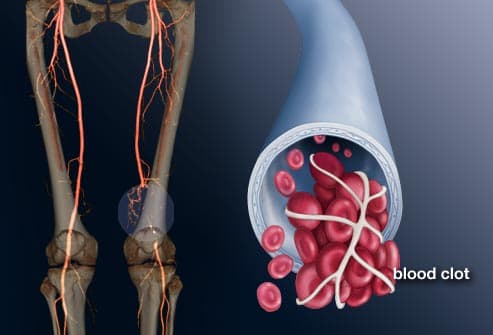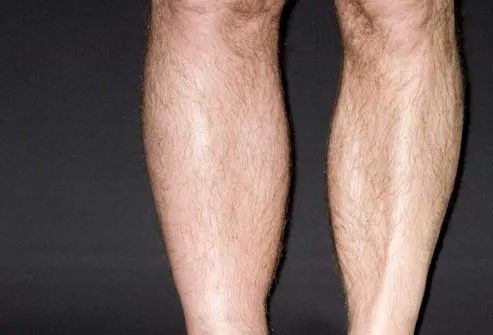Deep Vein Thrombosis(DVT)

Deep vein thrombosis refers to a blood clot that develops inside a larger vein -- usually deep within the lower leg or thigh. DVT strikes about half a million Americans every year and causes up to 100,000 deaths. The danger is that part of the clot can break off and travel through the bloodstream, where it can lodge in the lungs causing a blockage in blood flow, organ damage, and death.
Symptoms
Unfortunately, DVT often goes unnoticed. About half of people with DVT have no warning signs. Symptoms may include:
- Redness
- Swelling
- Tenderness or pain

Dangers of DVT: Pulmonary Embolism
If part of the clot breaks loose and travels through the bloodstream, the results can be life-threatening. A clot that blocks the blood supply to the lungs is called a pulmonary embolism. Symptoms include trouble breathing, low blood pressure, fainting, faster heart rate, chest pain, and coughing up blood. If you have any of these symptoms, call 911 and seek immediate emergency care.Causes DVT- Anything that damages the inner lining of a vein may cause DVT, including surgery, injury, or an immune system response. Blood that is thick or flows too slowly is more likely to form a clot, especially in a vein that is already damaged. Other things that raise the risk for blood clotting include genetic disorders, hormone changes, and sitting for long periods of time (such as when flying).
People with a higher risk of DVT include:
- People who have cancer
- People who have had surgery
- Anyone on extended bed rest
- The elderly
- Smokers
- Long-distance travelers
- People who are overweight or obese
Like pregnancy, hormonal birth control and postmenopausal hormone therapy change blood chemistry and may increase risk of DVT, even in women who don't have blood disorders.
Traveling to new and faraway places can be exciting. Squishing into a coach seat for a long international flight is not. Studies show long-distance travel lasting more than four hours doubles the risk of developing DVT. This includes travel by air, bus, train, or car. Not moving around in these cramped conditions can cause sluggish blood flow.
Diagnosing DVT-
An ultrasound is most often used to diagnose DVT. It uses sound waves to
create a picture of blood flow in the affected area and can reveal a
clot. Before recommending an ultrasound, your health care provider will
examine you and check for signs of DVT. Other tests, including a blood
test called a D-Dimer, may also be useful in diagnosing DVT. You may be
asked about your medical history, medications you are taking, family
history, and about any other factors that could raise your risk of DVT.
Treatment- Anticoagulants
Anticoagulants, which make the blood thinner, are the most common DVT treatment. They are taken as a pill or by injection. They can’t break up an existing clot, but they prevent new blood clots from forming, giving the body time to dissolve the clot on its own.Clot Busters
Medications that actually dissolve blood clots are called thrombolytics. They can cause sudden, severe bleeding, so they are used only in emergencies: for example, to dissolve a life-threatening blood clot that's traveled to the lungs and is causing severe symptoms. Thrombolytics are given by IV in a hospital.Side Effects of DVT Medications
Because anticoagulants thin the blood, people who take them may get bruises often or bleed more easily. Internal bleeding can be life-threatening, so if you take an anticoagulant, your doctor can test your blood to make sure it's not too thin. Some newer medications do not require routine lab monitoring of their blood-thinning effect.
THIS IS ONLY FOR INFORMATION, ALWAYS CONSULT YOU PHYSICIAN BEFORE
HAVING ANY PARTICULAR FOOD/ MEDICATION/EXERCISE/OTHER REMEDIES.
PS- THOSE INTERESTED IN RECIPES ARE FREE TO VIEW MY BLOG-
HTTP:GSEASYRECIPES.BLOGSPOT.COM/
PS- THOSE INTERESTED IN RECIPES ARE FREE TO VIEW MY BLOG-
HTTP:GSEASYRECIPES.BLOGSPOT.COM/
FOR INFO ABOUT KNEE REPLACEMENT, YOU CAN VIEW MY BLOG-
HTTP://KNEE REPLACEMENT-STICK CLUB.BLOGSPOT.COM/
FOR CROCHET DESIGNS
HTTP://MY CROCHET CREATIONS.BLOGSPOT.COM
FOR CROCHET DESIGNS
HTTP://MY CROCHET CREATIONS.BLOGSPOT.COM
Labels: anti-coagulant, blurred vision, clot busters, confusion, DVT(deep vein thrombosis), internal bleeding, pulmonary embolism (PE), severe headache, vomiting

0 Comments:
Post a Comment
<< Home